Introduction
Understanding and addressing the behavioral needs of children, especially those with disabilities, can be a challenging yet rewarding journey for parents and practitioners alike. Applied Behavior Analysis (ABA) offers a scientifically backed framework to foster positive behavior changes and support holistic development. This article delves into the core principles of ABA, the foundational ABC model, and key techniques such as positive reinforcement, visual modeling, and behavior chaining.
It also highlights the importance of correct implementation as emphasized by the latest guidelines from the Council of Autism Service Providers. By exploring these elements, the article aims to equip parents and practitioners with the knowledge and tools needed to create supportive, effective, and compassionate interventions for children.
Principles of ABA
Applied Behavior Analysis (ABA) is rooted in several key principles that shape its practice. Central to ABA is the understanding that actions are influenced by the environment. This perspective enables practitioners to observe and adjust actions within their specific contexts, tailoring interventions to be both effective and relevant. Measurement and data collection are also pivotal in ABA, ensuring that interventions are grounded in scientific evidence and can be assessed for their efficacy. The recent release of the third edition of the ABA Practice Guidelines by the Council of Autism Service Providers underscores the importance of maintaining high standards in implementation. These guidelines provide a comprehensive framework for practitioners, insurers, and regulatory bodies to follow, ensuring that ABA is delivered with the highest quality. The emphasis on visible actions and the situations in which they happen allows practitioners to recognize the elements that influence changes in actions, resulting in more precise and impactful interventions.
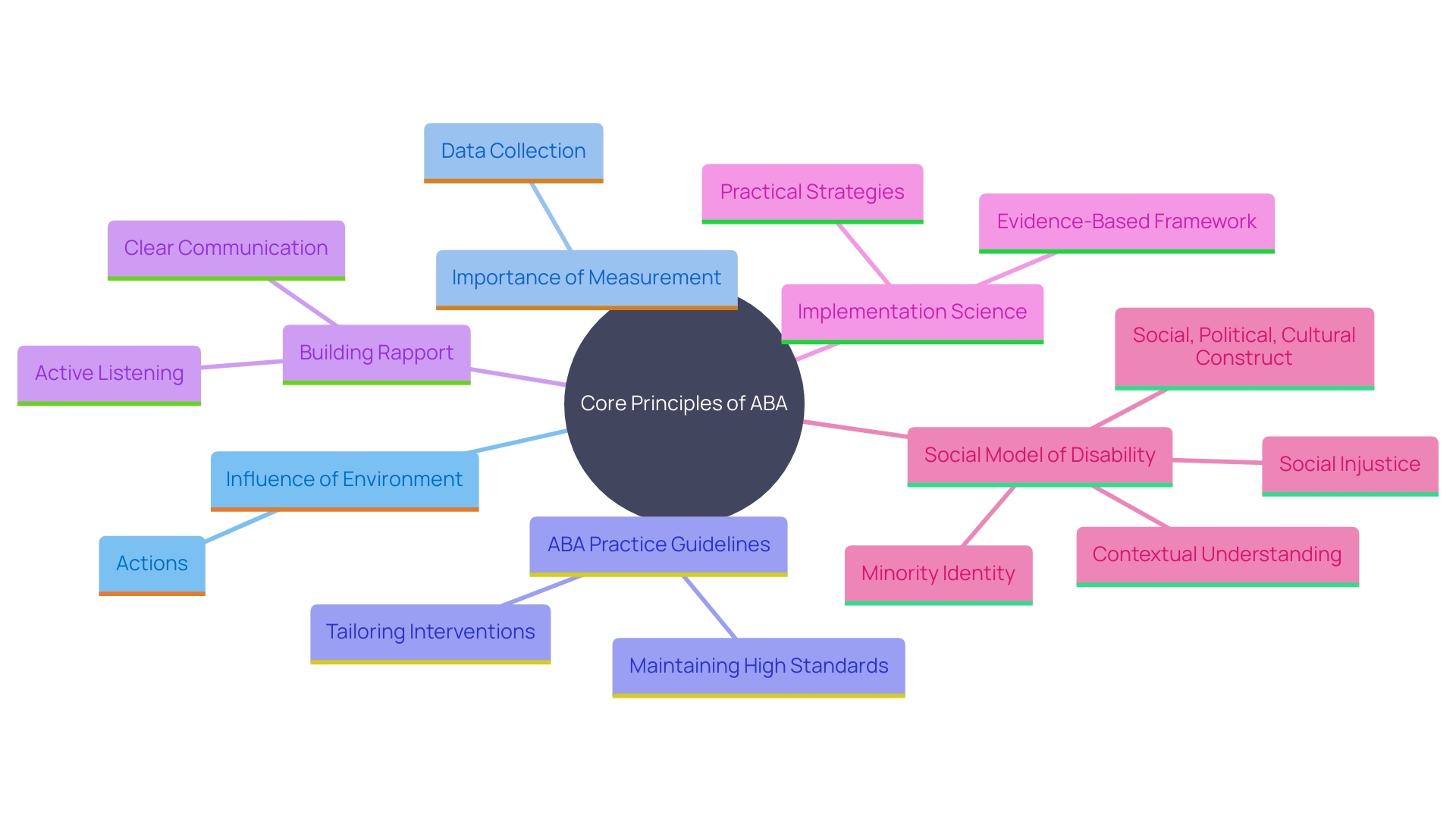
Key Components of ABA: Antecedents, Behaviors, and Consequences
At the core of Applied Behavior Analysis (ABA) is the ABC model, which includes antecedents, actions, and consequences. Antecedents are the specific triggers that lead to an action, whether it's a verbal cue, a visual stimulus, or a particular environment. The conduct is the observable action taken by the individual, such as speaking, moving, or engaging with an object. Consequences come after the actions and can either reinforce or discourage their recurrence. This model is fundamental for practitioners aiming to understand and modify behaviors effectively.
For example, according to the Council of Autism Service Providers (CASP), new guidelines emphasize the importance of properly implementing ABA to ensure high-quality treatment. These guidelines are crucial for setting standards of care for practitioners, insurers, and regulatory bodies. As Lorri Unumb, CEO of CASP, notes, “ABA is a highly effective treatment for autism. But it has to be correctly implemented at the highest quality.”
In practice, understanding the ABC model helps create fair and supportive environments for children with disabilities. Dr. David (Dan) R. Offord, a renowned psychiatrist specializing in youth, highlighted the importance of equitable participation for youngsters, stating, “I do not mind if my kids are in a race as long as the race is fair.” This underscores the necessity of recognizing each individual's unique needs and ensuring they have the resources to thrive.
Real-world applications of ABA, such as those promoted by Forta Health, concentrate on altering visible actions while being aware of the underlying cognitive and emotional processes. By addressing both the triggers and outcomes of actions, ABA practitioners can create more effective and compassionate interventions that support the holistic development of children.
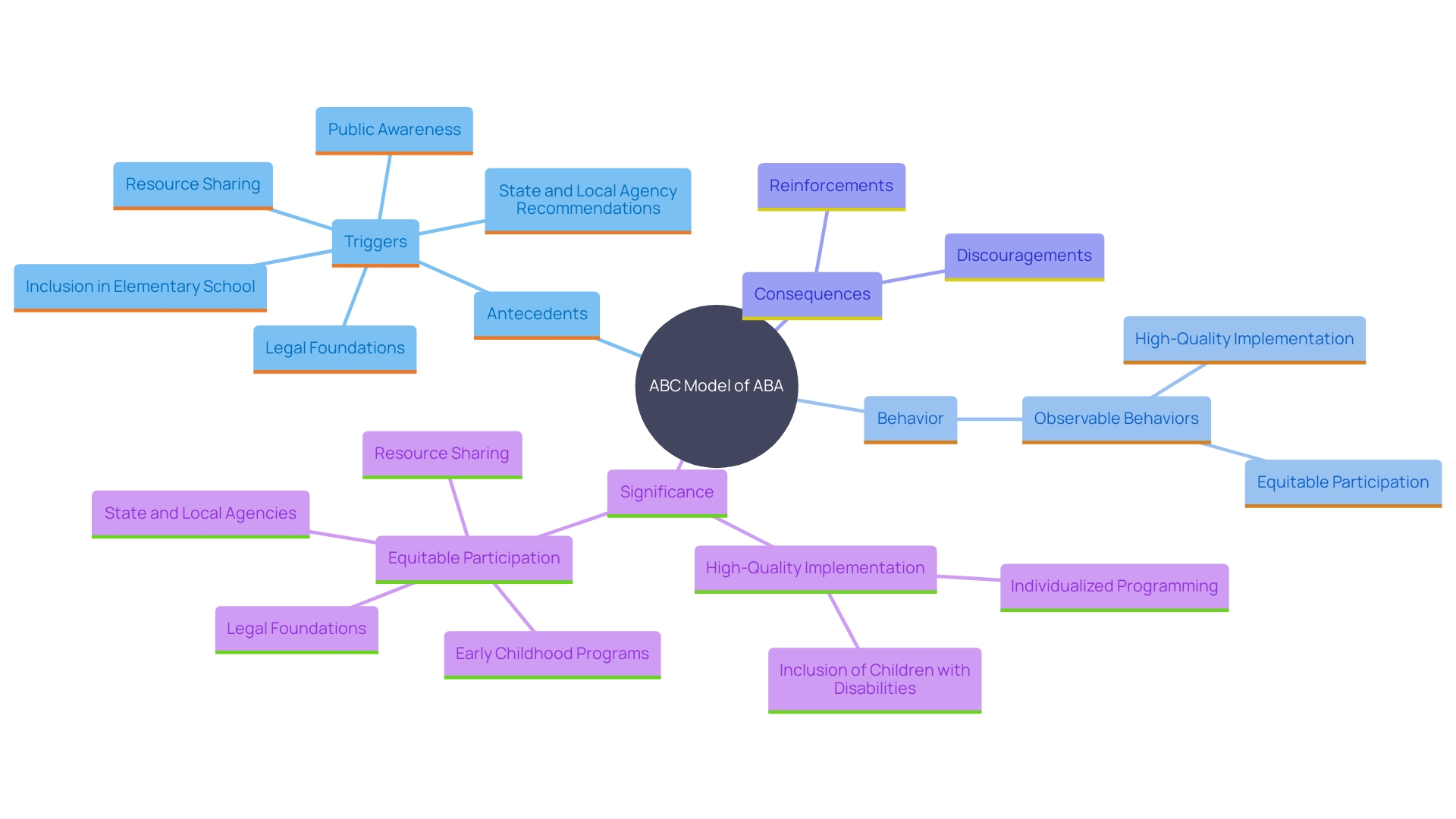
ABA Techniques for Practitioners
Applied Behavior Analysis (ABA) therapy utilizes a variety of methods to encourage positive changes, customized to address each person's specific requirements. These techniques encompass positive reinforcement, where favorable actions are rewarded to promote their repetition, and visual modeling, which employs visual tools to illustrate preferred actions. 'Another technique is behavior chaining, which breaks down complex tasks into smaller, manageable steps, making it easier for people to learn new skills incrementally.'.
The latest guidelines from the Council of Autism Service Providers (CASP) emphasize the importance of correctly implementing these techniques to maintain high-quality standards in ABA therapy. According to Lorri Unumb, CEO of CASP, “ABA is a highly effective treatment for autism. But it has to be correctly implemented at the highest quality.” These updated guidelines aim to ensure that practitioners, insurers, and other stakeholders adhere to rigorous standards, thereby maximizing the therapy's effectiveness.
Moreover, these techniques are not just theoretical; they are applied in real-world settings to bring about tangible improvements. For instance, the Autism BASICS app leverages similar principles by providing daily activities and learning-focused tasks, enabling parents and therapists to work closely with children to enhance their development.
Dr. Jan Blacher from UC Riverside emphasizes the changing comprehension of autism, pointing out that instances have risen from 1 in 2,500 to 1 in 36 people. This broader recognition of autism's spectrum underscores the need for individualized approaches in ABA therapy. Every method, whether it involves positive reinforcement, visual modeling, or skill chaining, is essential in assisting people to acquire new abilities and decrease difficult actions, ultimately enhancing their overall well-being.
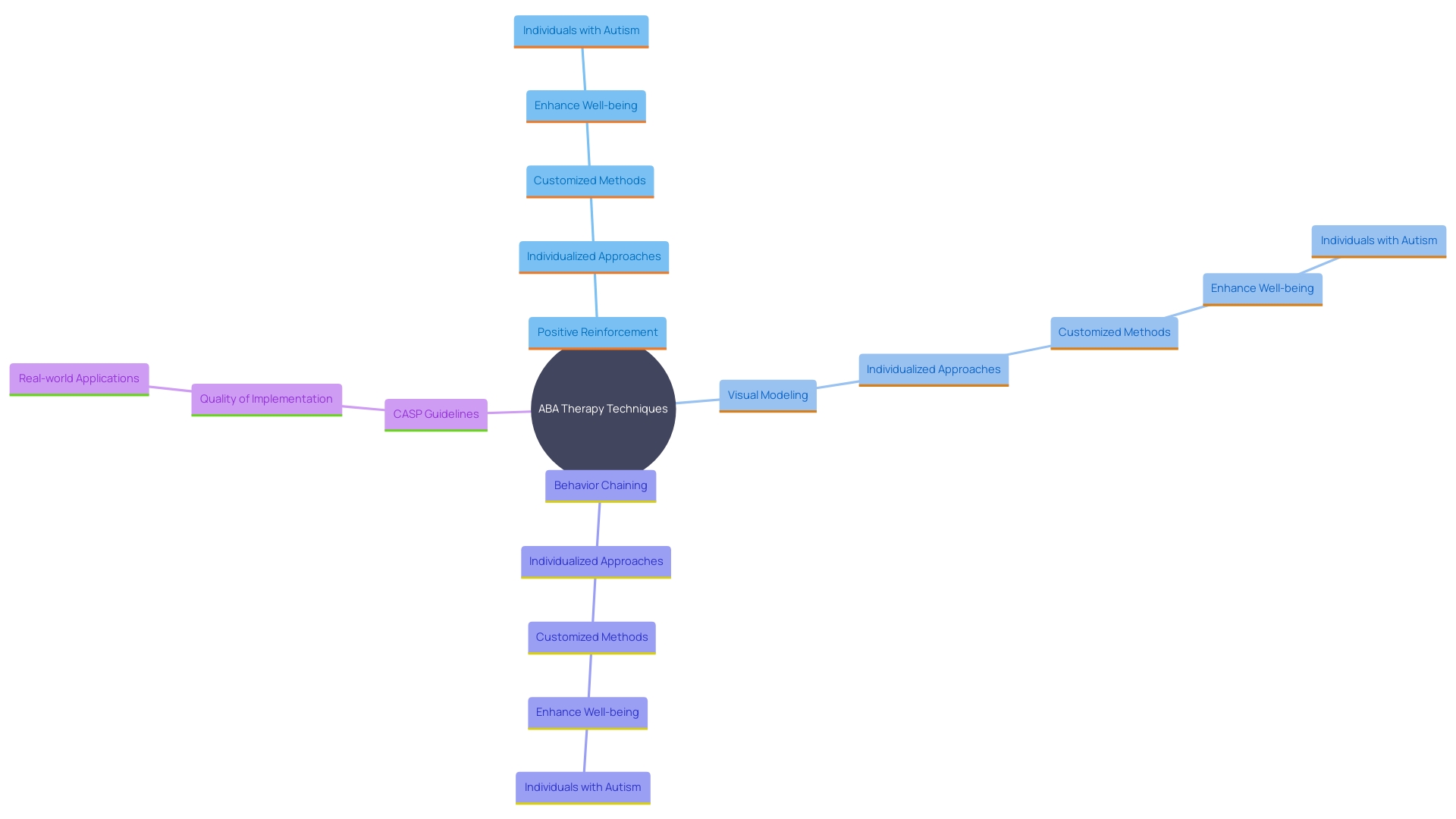
Positive Reinforcement
Positive reinforcement, a cornerstone in Applied Behavior Analysis (ABA) therapy, involves giving a reward after a desired action, thereby increasing the chance of that action being repeated. This method is instrumental in motivating people to engage in positive actions and fostering a sense of achievement. For instance, when a child successfully completes a task, offering praise or a small treat can significantly enhance their readiness to repeat the action. The Council of Autism Service Providers recently emphasized the importance of correctly implementing ABA to achieve high-quality outcomes. As Lorri Unumb, CEO of CASP, stated, “ABA is a highly effective treatment for autism. But it has to be properly executed at the highest standard. This approach is not just about rewards but about creating a supportive environment where people feel motivated to grow and succeed.
Visual Modeling
Visual modeling utilizes visual tools to illustrate preferred actions, proving especially effective for those who learn better through observation. By observing the behavior being demonstrated, people can more easily comprehend expectations and imitate the behavior. For instance, mimicking emotions involves learning to imitate facial expressions associated with different emotions, helping individuals grasp and reproduce these emotional cues. This technique has been pivotal in Applied Behavior Analysis (ABA) therapy, which aims to enhance social and communication skills in individuals with autism. The creation of the Autism BASICS app illustrates this method, offering daily activities and educational material to involve youth and promote parent-offspring collaboration. The app's success highlights the significance of visual modeling in therapy, providing a practical and engaging method for children to learn and implement new actions.
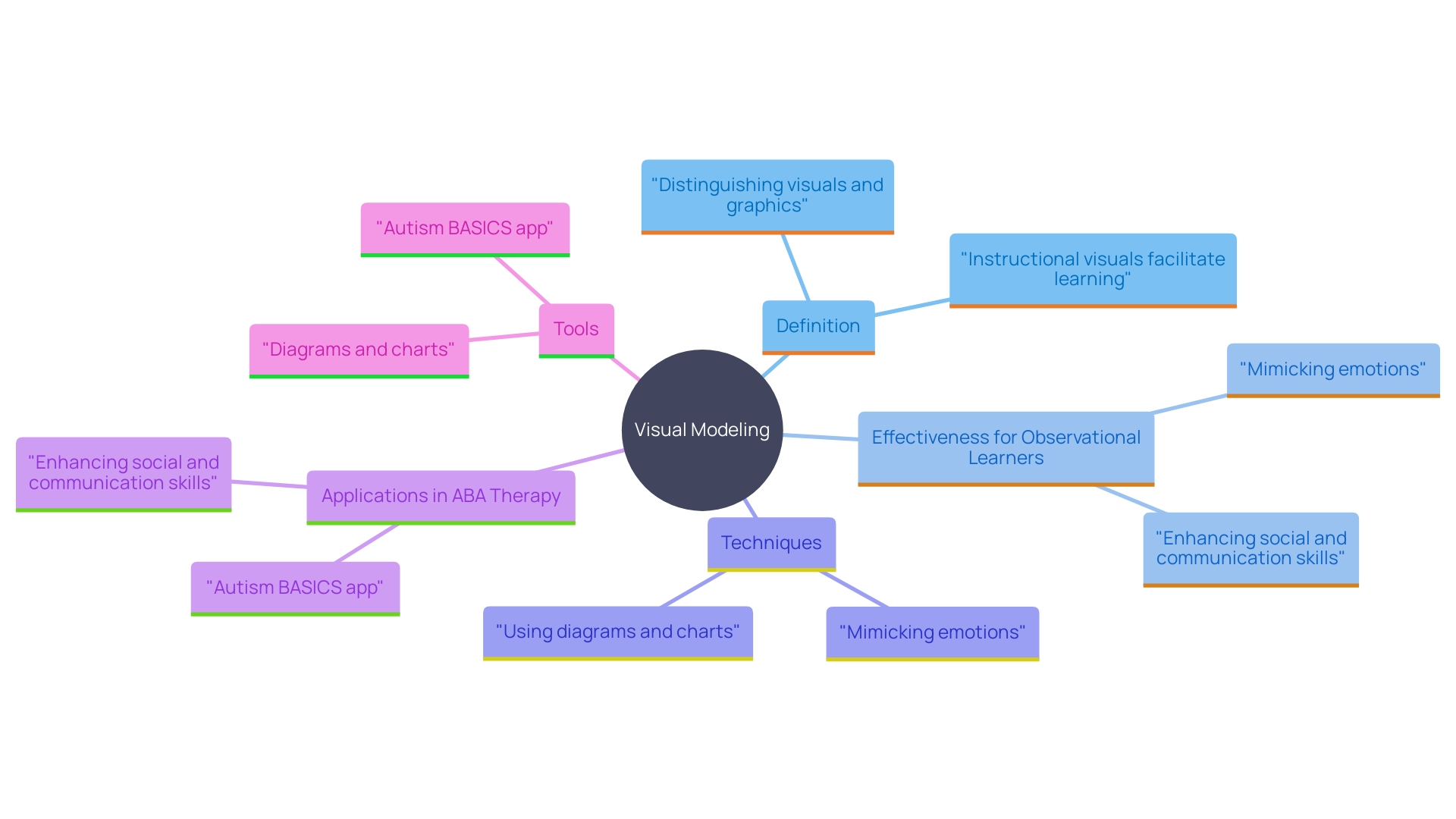
Behavior Chaining
Behavior chaining is a powerful technique in ABA therapy that simplifies complex tasks by breaking them down into smaller, manageable steps. Each step is taught in order, allowing participants to progressively master the complete action. This method not only facilitates skill acquisition but also significantly boosts confidence, as individuals experience a sense of achievement with each successfully completed step. As stated by the National Academies of Sciences, Engineering, and Medicine, evidence-supported methods such as chaining actions are crucial for promoting successful interventions. By concentrating on gradual achievements, this method aids in establishing a strong base for more intricate actions and promotes a constructive learning atmosphere.
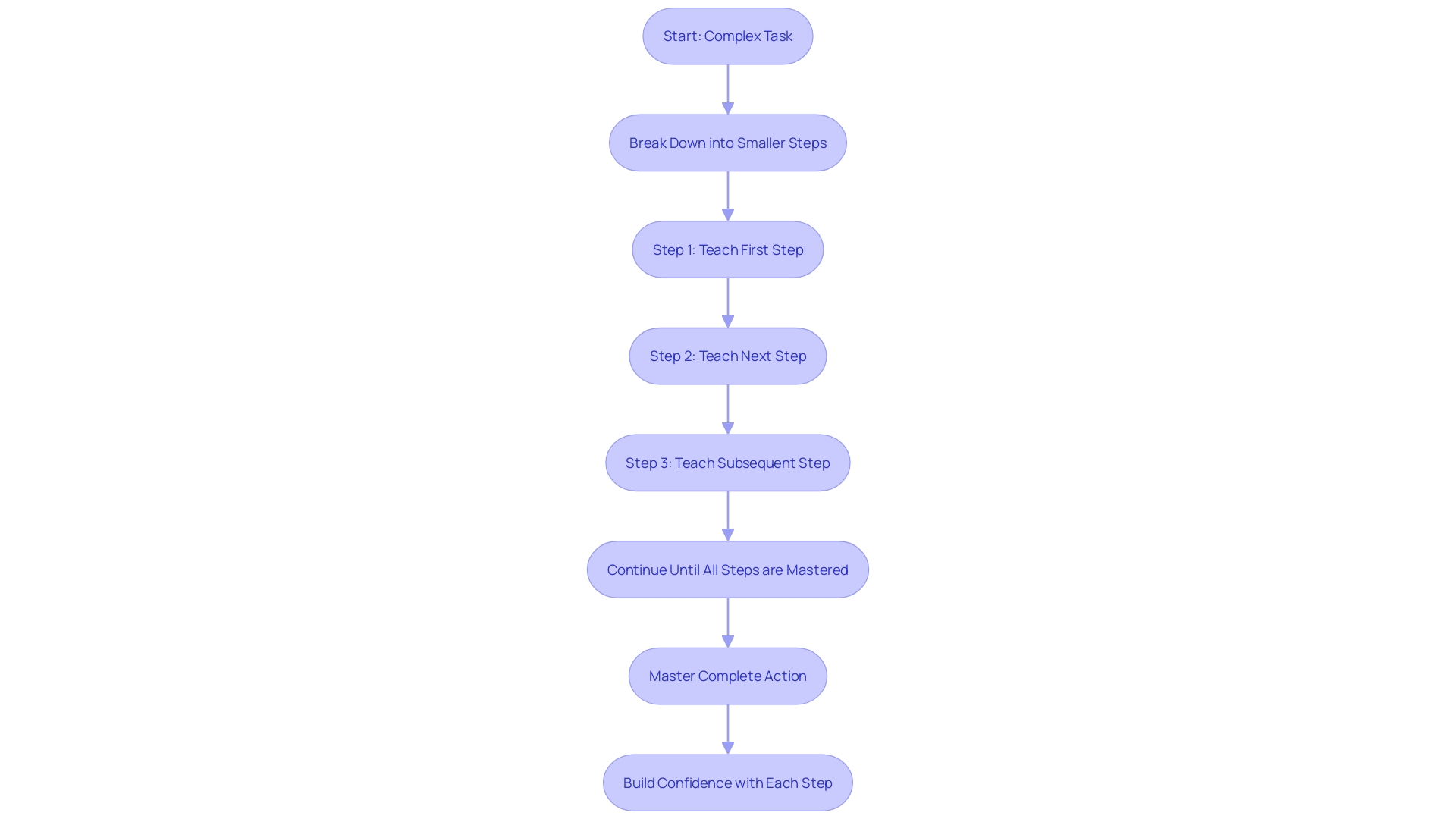
Script Fading
Script fading is a powerful technique that gradually reduces prompts or supports provided to a person when they are learning a new behavior. This method nurtures independence by allowing the individual to rely less on external cues over time, fostering self-sufficiency and confidence. Dr. David (Dan) R. Offord, a renowned pediatric psychiatrist, emphasized the importance of providing equitable support for young individuals, especially those with disabilities, to ensure their well-being and mental health. By carefully implementing script fading, caregivers can help young individuals develop the skills they need to navigate their environments independently. This approach is crucial for creating a fair 'race' where all children, regardless of their challenges, can thrive and contribute to their communities.
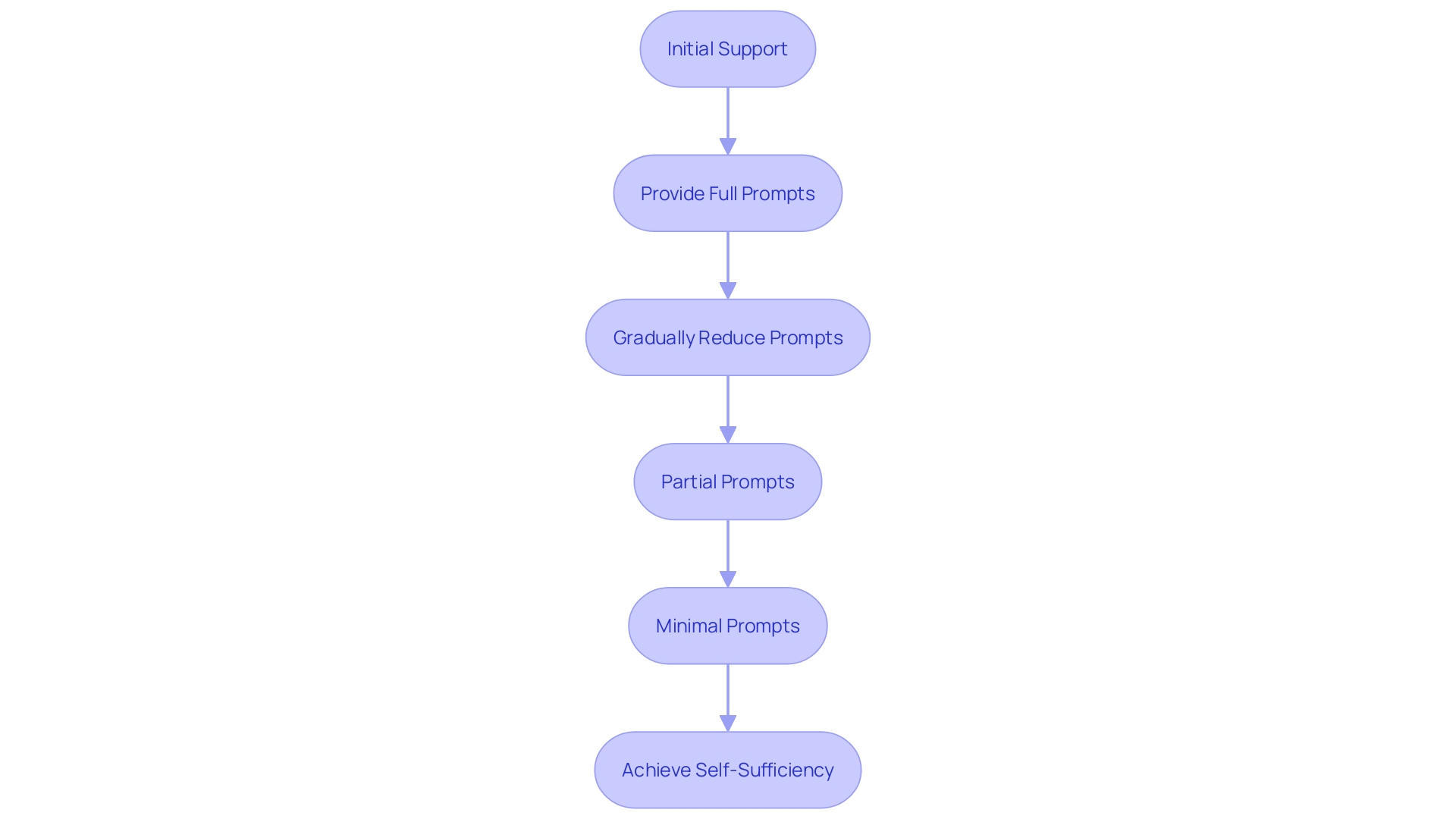
Discrete Trial Training (DTT)
Discrete Trial Training (DTT) is a highly structured teaching method used in ABA therapy that simplifies complex skills into small, manageable steps. Each trial within this approach involves a clear instruction given to the participant, followed by their response and immediate feedback. This organized approach not only facilitates skill development but also assists people in grasping the connection between their actions and the anticipated results. This precise and systematic approach is particularly beneficial for children and youth with autism, who often face co-occurring emotional and behavioral challenges. By breaking down tasks into discrete trials, DTT fosters an environment where learning is clear, consistent, and measurable, ultimately supporting the individual's development and participation in daily activities.
Antecedent-Based Interventions (ABI)
Applied Behavior Analysis (ABA) therapy focuses on modifying the environment to proactively tackle difficult actions. By strategically adjusting antecedents, practitioners can create environments that anticipate and mitigate potential triggers. This proactive approach not only encourages positive actions but also significantly minimizes disruptions. According to Dr. David (Dan) R. Offord, ensuring that children, including those with disabilities, are well-supported in their daily environments is crucial for their mental health and overall development.
Functional Behavior Assessment (FBA)
Functional Behavior Assessment (FBA) is a structured method focused on revealing the underlying reasons for problematic actions. By meticulously gathering data and scrutinizing conduct patterns, practitioners can design specific interventions that not only target the actions but also address their underlying function. This comprehensive method ensures more effective and lasting behavior modification. As Dr. David (Dan) R. Offord, a renowned psychiatrist specializing in youth, emphasized, “I do not mind if my offspring are in a race as long as the race is fair.” This sentiment underscores the importance of creating equitable opportunities for all young individuals, particularly those with disabilities. 'Ensuring that interventions are customized to the specific needs of children contributes to their engaged, peaceful, and well-supported participation in school, home, and community activities, which is vital for their mental health and overall development.'.
Applications of ABA
ABA techniques are versatile and can be applied effectively in various settings, including education, healthcare, and business. Each application aims to improve actions, learning, and overall well-being. For instance, the municipality of Hafnarfjordur in Iceland has seen remarkable results by implementing ABA strategies across different scenarios, supported by the Icelandic Technology Fund. This initiative has significantly benefited young people's education and mental health. Moreover, recent updates from the Council of Autism Service Providers highlight the importance of correct implementation of ABA to ensure high-quality treatment for autism. By adapting ABA techniques to diverse environments, practitioners can support individuals in achieving their goals, fostering positive changes, and improving essential skills.
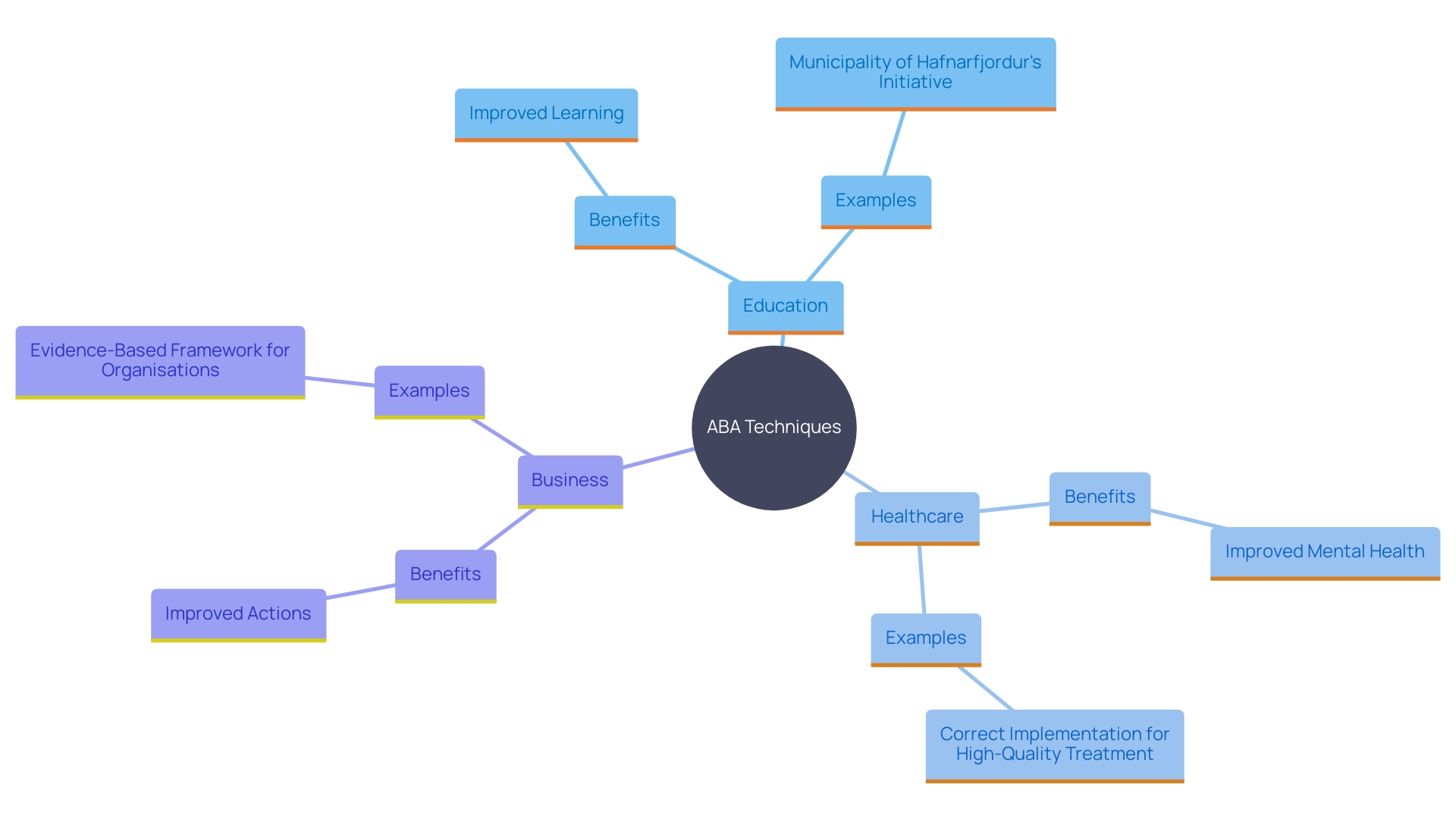
Education: Addressing Behavioral Challenges in Students
In educational settings, ABA therapy plays a crucial role in addressing behavioral challenges among students. By implementing interventions tailored to each student's needs, educators foster structured learning environments that encourage positive actions, enhance engagement, and support academic achievement. The recent guidelines from the Council of Autism Service Providers emphasize the importance of high-quality, correctly implemented ABA practices to achieve these outcomes. Furthermore, building alliances between schools, families, and healthcare providers ensures a holistic approach, aligning with the social model of disability that views disability within a broader social and cultural context. This integrated effort is essential for creating inclusive educational settings where all students can thrive.
Business: Organizational Behavior Management
The principles of Applied Behavior Analysis (ABA) can transform business environments by improving organizational conduct. By meticulously analyzing employee performance and incorporating reinforcement strategies, companies can cultivate a positive workplace culture, significantly boosting productivity and employee satisfaction. For instance, AT&T, a company with a deep-rooted history, faced bureaucratic inefficiencies that hampered employee morale. An employee survey revealed widespread frustration with existing systems, prompting a reevaluation of workplace processes. This approach aligns with the experiences of IBL, a global conglomerate with over 26,000 employees. Despite a strong culture of innovation, IBL recognized the need for a balanced portfolio to address fluctuating market conditions exacerbated by the COVID-19 pandemic and other factors. By applying ABA principles, organizations like these can not only streamline operations but also foster an environment that values and motivates its workforce.
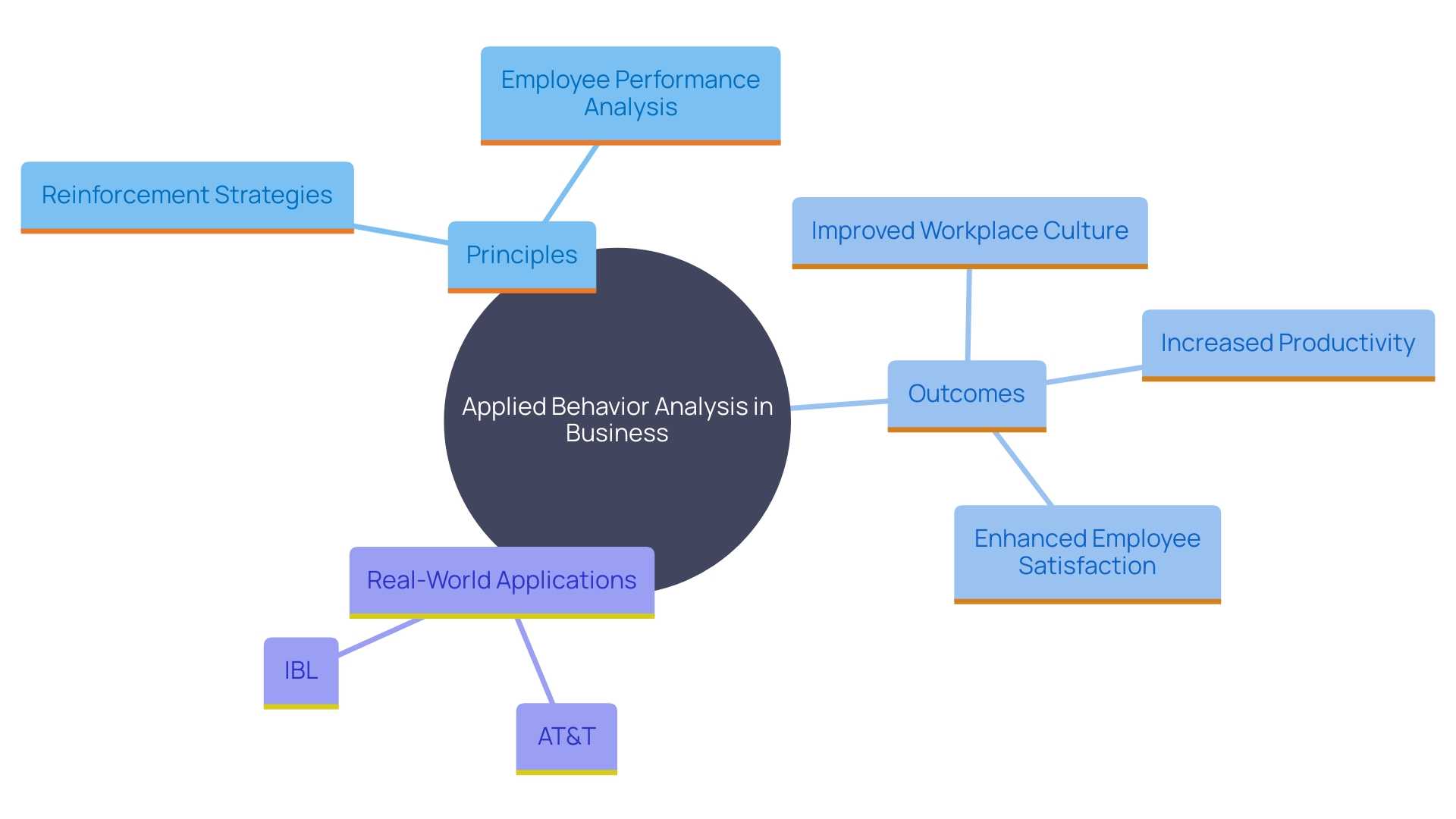
Mental Health: Identifying Factors Contributing to Disorders
In mental health, ABA techniques can be pivotal in identifying and addressing behavioral factors contributing to disorders. By concentrating on visible actions and their underlying purposes, practitioners can develop specific interventions that assist people in managing conditions effectively. For instance, disorders characterized by violence and aggression, such as conduct disorder and antisocial personality disorder, often present significant challenges. Conduct disorder impacts as many as 16 percent of males and 9 percent of females, resulting in actions such as theft and intentional injury to others. Addressing these actions early through ABA techniques can significantly alter the affected individual’s life trajectory.
Psychologists note that while these disorders are both prevalent and severe, they are often underdiagnosed and undertreated, despite the availability of effective treatments. Early intervention and well-timed care delivery are crucial in these cases. Research highlights the importance of integrating evidence-based practices, such as cognitive behavioral therapy (CBT) and pharmacotherapies, into treatment plans. However, the uptake of these practices in mental health settings has been weak, often due to economic and organizational barriers.
Furthermore, a case study shows that families managing aggressive actions in children frequently invest thousands in specialized schools and treatments, yet still face difficulties without appropriate direction. Building trust and clear communication with parents is vital, as it reassures them that their concerns are heard and their input is valued. Active listening and partnership in the process empower parents, enhancing the effectiveness of interventions. ABA techniques, therefore, provide a structured, evidence-supported method for managing and enhancing actions linked to complex mental health disorders.
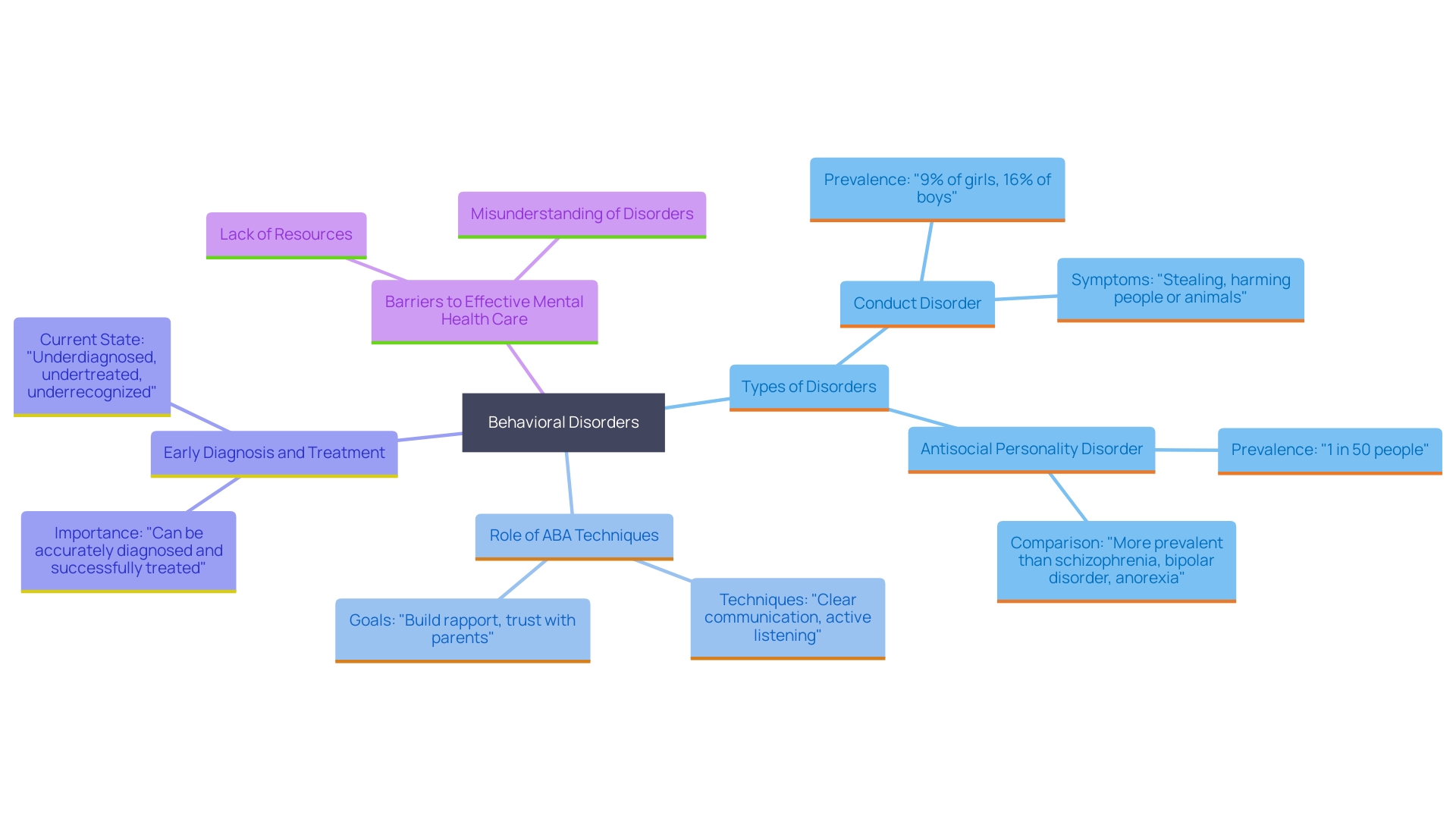
Evidence-Based Practice: Research Supporting ABA
The effectiveness of ABA therapy is solidly supported by extensive research, demonstrating its success in promoting positive behavior changes across diverse populations. Evidence-based practice ensures that interventions are deeply rooted in scientific findings, providing practitioners with the confidence to implement strategies that yield meaningful outcomes. This approach has been particularly beneficial in various settings, including primary care and childcare centers, where non-traditional workforces have successfully increased access to effective services.
Dr. Kearney’s research highlights how concepts from implementation science can be used to translate these findings into practical strategies, enhancing the reach and impact of ABA practices. Moreover, the National Academies of Sciences, Engineering, and Medicine emphasize the importance of using the latest scientific findings to shape sound policies and inform public opinion. Their peer-reviewed reports and journals present evidence-based consensus, which is crucial for advancing the fields of science, engineering, and medicine.
One significant element in the success of ABA is the use of randomized controlled trials (RCTs), which offer robust evidence for the efficacy of interventions. These trials are often complemented by quasi-experimental studies that provide additional insights, ensuring a comprehensive understanding of the therapy's impact. As a result, clinicians can choose interventions based on the most recent research, customizing their approaches to meet the unique needs of young individuals and their families.
The LEAP Lab at the University of Texas at Austin exemplifies this commitment to expanding the reach of evidence-based practices. Their work concentrates on reworking aspects of these practices to engage young individuals and families in non-mental health environments. This approach not only broadens the impact of ABA therapy but also addresses the challenges of implementation in diverse environments.
In conclusion, the robust evidence supporting ABA therapy, combined with the ongoing efforts to expand its reach, ensures that practitioners can confidently implement strategies that lead to meaningful and positive outcomes for children with autism and ADHD.
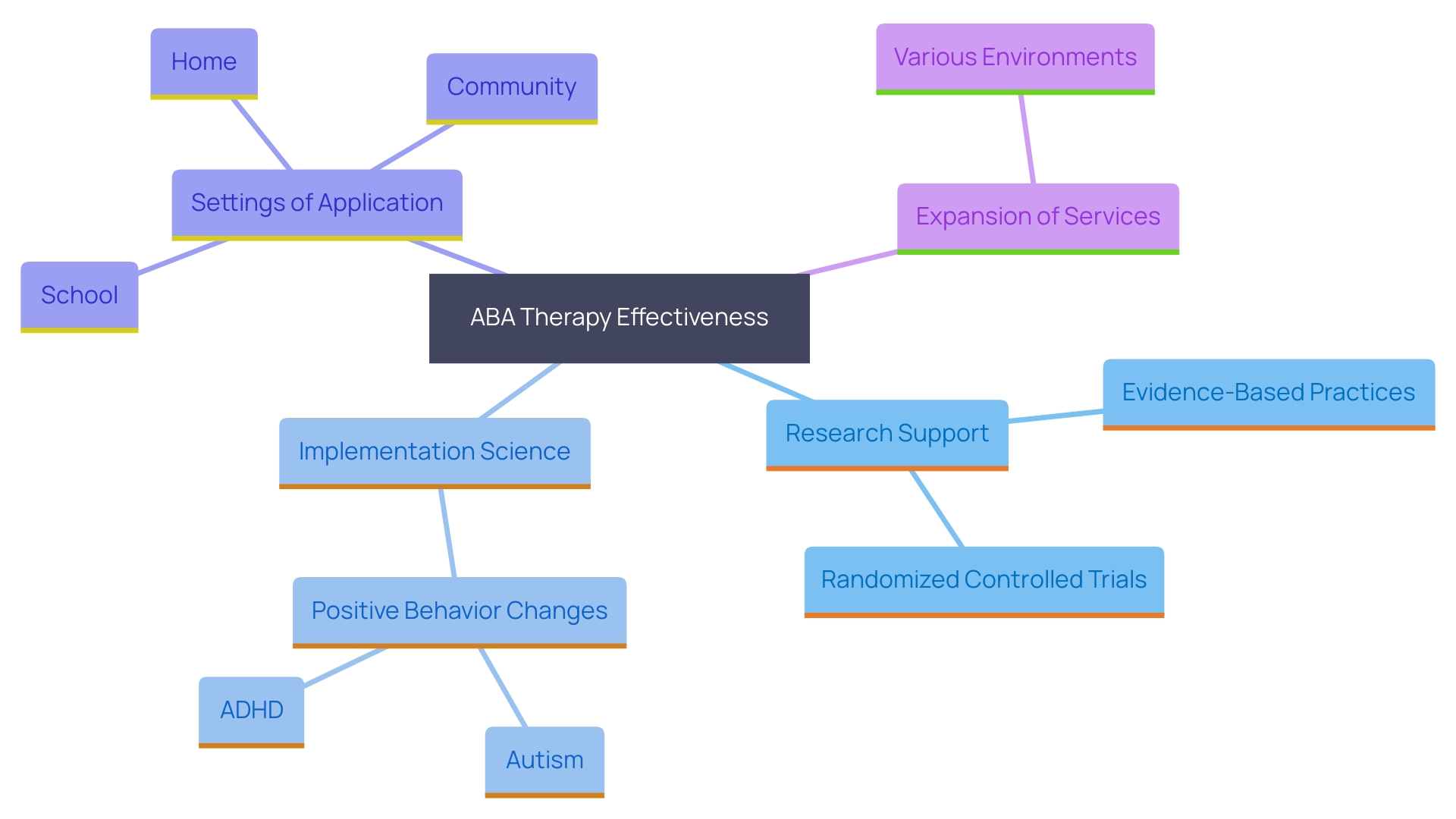
Conclusion
Understanding the complexities of Applied Behavior Analysis (ABA) reveals its profound impact on supporting children with disabilities. The core principles of ABA emphasize the importance of context, measurement, and data collection, ensuring interventions are both effective and scientifically grounded. With the recent updates from the Council of Autism Service Providers, maintaining high standards in implementation is more critical than ever, reinforcing the commitment to quality care.
The ABC model—antecedents, behaviors, and consequences—serves as a fundamental framework for practitioners to understand and modify behaviors effectively. Techniques such as positive reinforcement, visual modeling, and behavior chaining not only facilitate skill acquisition but also nurture a positive learning environment. These strategies empower children to thrive, fostering independence and confidence in their abilities.
Moreover, the versatility of ABA techniques extends beyond education to various sectors, including healthcare and business. By applying these principles, organizations can enhance overall well-being and performance. In mental health settings, ABA plays a vital role in identifying and addressing behavioral factors that contribute to disorders, highlighting the necessity of early intervention.
The evidence-based nature of ABA therapy, supported by extensive research, ensures that interventions are tailored to the unique needs of each child. This structured approach not only promotes positive behavior changes but also cultivates an inclusive atmosphere where every child has the opportunity to succeed. By embracing the principles and techniques of ABA, parents and practitioners can create meaningful, compassionate interventions that significantly enhance the lives of children with disabilities.




